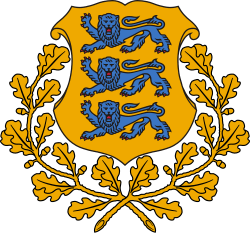Estonian restoration of Independence
Estonian Restoration of Independence (juridically defined as the Restoration of the Republic of Estonia) is celebrated on the 20th of August as on that day, in 1991 at 11:02 pm [1] local time, the Estonian Supreme Soviet, in agreement with the Estonian Committee (the executive organ of the Estonian Congress) proclaimed Estonian independence from the Soviet Union.[2] August 20 is a public holiday in Estonia.
The 1991 Soviet coup d'état attempt
The August Coup or August Putsch lasted between 19–22 August 1991 and was an attempt by members of the Soviet Union’s government to take control of the country from the Soviet President and General Secretary Mikhail Gorbachev.
August 19th, 1991
As the coup attempt was taking place in Moscow and with that the military and political attention of the Soviet Union otherwise occupied, various republics of the Soviet Union took the opportunity to declare their independence. On the evening of the 19th of August, delegates from the Estonian Supreme Soviet and the Estonian Committee started negotiations to declare the independence of the Republic of Estonia. The main debate was a crucial one: should Estonia declare independence as a new Republic or continue with the juridical continuation of the Republic of Estonia established in 1918 and occupied in 1940.
August 20th, 1991
At 11:02 pm on the evening of August 20, 1991, during a live broadcast carried out by the National Television, the Estonian Supreme Soviet voted on the declaration of its Restoration of Independence. Out of the 105 delegates of the Estonian Supreme Soviet 70 were present, 69 voted in favour of the restoration. Two delegates, Klavdia Sergij and Kaido Kama, did not register to vote and walked out before voting began. Those who voted in favour of the restoration:[3]
- Ülle Aaskivi
- Mati Ahven
- Andres Ammas
- Tõnu Anton
- Uno Anton
- Lembit Arro
- Hillar Eller
- Kaljo Ellik
- Ignar Fjuk
- Illar Hallaste
- Liia Hänni
- Arvo Junti
- Jaak Jõerüüt
- Rein Järlik
- Ants Järvesaar
- Villu Jürjo
- Hillar Kalda
- Teet Kallas
- Peet Kask
- Johannes Kass
- Kalju Koha
- Valeri Kois
- Mai Kolossova
- Jüri Kork
- Toomas Kork
- Heino Kostabi
- Ahti Kõo
- Tiit Käbin
- Ants Käärma
- Mart Laar
- Marju Lauristin
- Enn Leisson
- Jüri Liim
- Jaan Lippmaa
- Alar Maarend
- Tiit Made
- Mart Madissoon
- Tõnis Mets
- Aavo Mölder
- Ülo Nugis
- Ants Paju
- Eldur Parder
- Heldur Peterson
- Andrei Prii
- Priidu Priks
- Jüri E. Põld
- Enn Põldroos
- Koit Raud
- Jüri Reinson
- Andrus Ristkok
- Jüri Rätsep
- Arnold Rüütel
- Tõnu Saarman
- Edgar Savisaar
- Hanno Schotter
- Lehte Sööt
- Aldo Tamm
- Rein Tamme
- Andres Tarand
- Indrek Toome
- Enn Tupp
- Ain Tähiste
- Uno Ugandi
- Ülo Uluots
- Heinrich Valk
- Ants Veetõusme
- Rein Veidemann
- Helgi Viirelaid
- Vaino Väljas
August 21st, 1991
On the morning of August 21, 1991, Soviet paratroopers were taking charge of the Tallinn’s TV tower, while the television broadcast was cut off for a while, the radio signal was strong as a handful of Estonian Defence League (the unified paramilitary armed forces of Estonia) members barricaded the entry into signal rooms.[4] By the afternoon of the same day it was clear that the coup in Moscow had failed and the paratroopers released the tower and left Estonia.[5]
